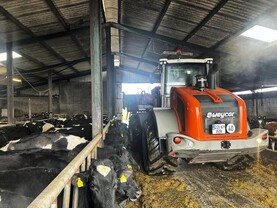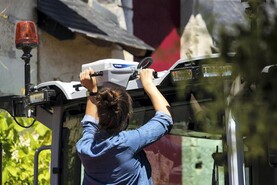First entering the agricultural telescopic loader market in 2011, Bobcat is a relatively new player in the agricultural telehandler market, especially here in Ireland. Initially introducing two models, the company has increased its agri portfolio to seven telescopic loaders with three levels of specification.
At an initial glance, the TL38.70HF is a well-built, impressive and modern-looking telehandler. Weighing in at 7,580kg, the model that we tested was shod on 460/70 R24 Michelin XMCL tyres. The Bobcat range encompasses some impressive features as standard such as the automatic electric handbrake, a programmable reversing fan and a cushioning system on the boom retract.
The TL38.70HF sports Bobcats own 3.4 litre engine. This four-pot powertrain generates a sizeable 130hp (97kW). This engine is compliant with the Stage IV regulations. The machine certainly wasn’t left wanting for power from the four-cylinder engine which also proved to be quite efficient on fuel and on AdBlue. The engine was also notably quiet in operation. Once the single-piece bonnet is folded up, the air filters, oil filters, oil reservoirs and the radiator can be easily accessed for regular maintenance and servicing.
Transmission
The handler has a hydrostatic transmission which is complemented by a two-speed mechanical gearbox, known as a hydro-mechanical box. A rocker switch on the dash is used to change between the two gear ranges.
One slight disadvantage is that the machine has to be at a complete standstill before you can change ranges.

The handler has a hydrostatic transmission which is complemented by a two-speed mechanical gearbox, known as a hydro-mechanical box.
Both first and second gears have a high and a low range. This is thanks to the two-speed hydrostatic motor (sourced from Danfoss) that can be changed on the move.
The high flow (HF) technology feature means the load-sensing pump supplies a sizeable 190l/min at 250 bars (150 l/min for the auxiliary line). The HF feature means that when using the hydraulic functions simultaneously, the hydraulics still proved to be very fast. This was one of the stand-out features of the machine. We understand the hydraulic pump is sourced from Casappa.
Cab
The cab in the TL38.70HF boasts a five-pillar design, with the rear back right post removed for increased visibility to the wheel. Overall visibility is good, but the bonnet to the right of the machine does slightly hinder visibility. Despite the heavy presence of grey plastic inside the cab, it is presented as a pleasant working environment. For the most part, the controls were simplistic and straightforward.
As expected, the electro-proportional joystick controlled FNR (Forward/Neutral/Reverse), all boom movements, the auxiliary controls and the machine setting controls including the boom suspension. As the forward/reverse shuttle is on the top of the joystick, in between the pushing out/retracting of the boom and the third service, it almost limits the possibility of carrying out more than one function at a time, as your thumb has to perform two tasks.

The HF (high flow) technology feature means the load-sensing pump supplies a sizeable 190l/min at 250 bars (150 l/min for the auxiliary line).
Perhaps the shuttle may have been better suited to the underside of the joystick, where the index finger could flick the shuttle into forward or reverse.
Another stand-out feature we really liked was the automatic engaging and disengaging of the handbrake, comparable to what we have become accustomed to in modern cars. The handbrake will be automatically engaged when the machine is in neutral for three seconds.
Similarly, it is also automatically engaged when the machine is at low engine revs or when the engine is turned off.
To read our verdict and the extended feature, check out this week’s paper.
First entering the agricultural telescopic loader market in 2011, Bobcat is a relatively new player in the agricultural telehandler market, especially here in Ireland. Initially introducing two models, the company has increased its agri portfolio to seven telescopic loaders with three levels of specification.
At an initial glance, the TL38.70HF is a well-built, impressive and modern-looking telehandler. Weighing in at 7,580kg, the model that we tested was shod on 460/70 R24 Michelin XMCL tyres. The Bobcat range encompasses some impressive features as standard such as the automatic electric handbrake, a programmable reversing fan and a cushioning system on the boom retract.
The TL38.70HF sports Bobcats own 3.4 litre engine. This four-pot powertrain generates a sizeable 130hp (97kW). This engine is compliant with the Stage IV regulations. The machine certainly wasn’t left wanting for power from the four-cylinder engine which also proved to be quite efficient on fuel and on AdBlue. The engine was also notably quiet in operation. Once the single-piece bonnet is folded up, the air filters, oil filters, oil reservoirs and the radiator can be easily accessed for regular maintenance and servicing.
Transmission
The handler has a hydrostatic transmission which is complemented by a two-speed mechanical gearbox, known as a hydro-mechanical box. A rocker switch on the dash is used to change between the two gear ranges.
One slight disadvantage is that the machine has to be at a complete standstill before you can change ranges.

The handler has a hydrostatic transmission which is complemented by a two-speed mechanical gearbox, known as a hydro-mechanical box.
Both first and second gears have a high and a low range. This is thanks to the two-speed hydrostatic motor (sourced from Danfoss) that can be changed on the move.
The high flow (HF) technology feature means the load-sensing pump supplies a sizeable 190l/min at 250 bars (150 l/min for the auxiliary line). The HF feature means that when using the hydraulic functions simultaneously, the hydraulics still proved to be very fast. This was one of the stand-out features of the machine. We understand the hydraulic pump is sourced from Casappa.
Cab
The cab in the TL38.70HF boasts a five-pillar design, with the rear back right post removed for increased visibility to the wheel. Overall visibility is good, but the bonnet to the right of the machine does slightly hinder visibility. Despite the heavy presence of grey plastic inside the cab, it is presented as a pleasant working environment. For the most part, the controls were simplistic and straightforward.
As expected, the electro-proportional joystick controlled FNR (Forward/Neutral/Reverse), all boom movements, the auxiliary controls and the machine setting controls including the boom suspension. As the forward/reverse shuttle is on the top of the joystick, in between the pushing out/retracting of the boom and the third service, it almost limits the possibility of carrying out more than one function at a time, as your thumb has to perform two tasks.

The HF (high flow) technology feature means the load-sensing pump supplies a sizeable 190l/min at 250 bars (150 l/min for the auxiliary line).
Perhaps the shuttle may have been better suited to the underside of the joystick, where the index finger could flick the shuttle into forward or reverse.
Another stand-out feature we really liked was the automatic engaging and disengaging of the handbrake, comparable to what we have become accustomed to in modern cars. The handbrake will be automatically engaged when the machine is in neutral for three seconds.
Similarly, it is also automatically engaged when the machine is at low engine revs or when the engine is turned off.
To read our verdict and the extended feature, check out this week’s paper.








 This is a subscriber-only article
This is a subscriber-only article









SHARING OPTIONS: